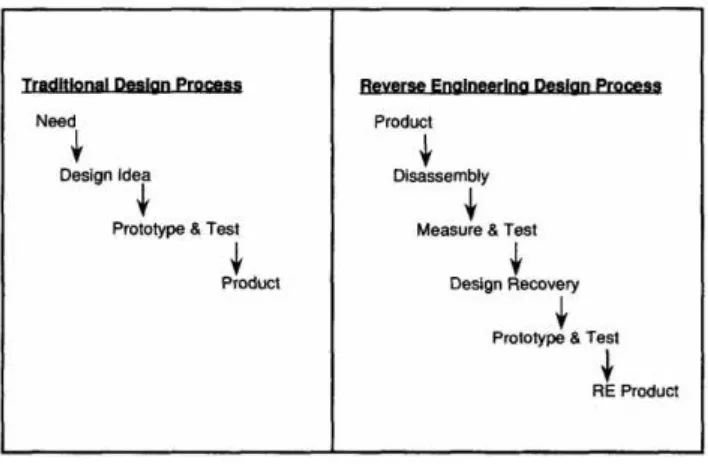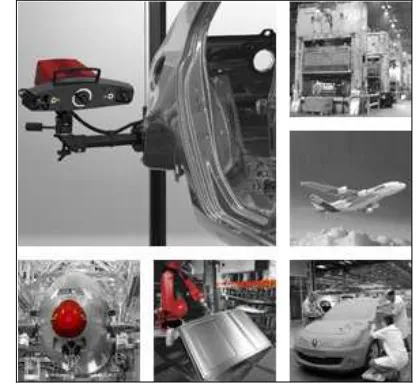1
CHAPTER 1
INTRODUCTION
1.1 Introduction
This reverse engineering of hand phone housing plastic injection mold is done due to its advantages in reducing production cost and to shorten the development process. The reverse engineering is a process that used to create 3D CAD (Computer Aided Design) models directly from physical parts with accurate dimension. This is used in order to redesign a product for better manufacturability. Usually, high technology and modern manufacturing method is used so that a component can be quickly and accurately reverse engineered. For a product of hand phone housing, the most important thing that should be considered is the dimension and tolerance of each part and features because each part is connected to one another and a problem will occur if the dimension is not accurate. A good design of core and cavity is needed to produce a perfect product.
2
As computer-aided design has becoming more popular, reverse engineering has become a viable method to create a 3D virtual model of an existing physical part for use in 3D CAD, CAM, CAE and other software. The reverse engineering process involves measuring an object and then produces a 3D model. The physical object can be measured using 3D scanning technologies like CMMs and laser scanners or other handling tool such as vernier caliper. CAM is Computer Aided Manufacturing that involves the use of computers to assist in all phases of manufacturing a product. (Serope Kalpakjian, Manufacturing Engineering and Technology fifth edition, 2006)
1.2 The objectives of the research
The objective of the study is to develop and redesign the product with the application of the reverse engineering process. This study is requires the student to be creative and apply reverse engineering tools and experience high and research technology that is not experienced in their learning education classes. The main focused in this study is to build a core and cavity for hand phone housing with the application of reverse engineering, to analyze the important of each part in hand phone cover to improve its design and to analyze the injection molding process in producing the product.
The main objectives of the research are:
1. To determine the dimension of the hand phone housing by using the best existing equipment at UTEM.
2. To select the material, based on suitable composition, properties, elasticity modulus and poison ratio of the hand phone housing material.
3. To apply the entire related machine in UTEM in order to complete the research. 4. To generate a 3D design of the mould of the hand phone housing.
3 1.3 Scope of study
a. This study will be involves the literature review of reverse engineering, mould, injection molding, reverse engineering tools and software used.
b. To apply reverse engineering method is to obtain the solid model of hand phone housing and detail design of existing product.
c. To study features of existing product and minimize if possible.
1.4 Problem statement
The study is done to mold for hand phone housing of Nokia 6680. The design of the mold can reduce the production time of the product in the future beside to reduce the cost of the production. Nokia 6680 is already existed in market, so a reverse engineering is important to redesign the hand phone housing for other usage. A reverse engineering is a way to reduce the development process and reduce the production costs of a product and this will clearly show us the importance of the hand phone housing to be reverse engineer to enhance the product.
1.5 Research
1.51 3D Laser Scanner
4
of Flight and X-Ray. Within the broader topic of 3D Laser Scanning, there are two types of device which operate in different ways and produce radically different results:
1. Triangulating 3D Laser Scanners 2. Time of Flight 3D Laser Scanners.
1.52 Coordinate Measuring Machine (CMM)
A Coordinate-measuring machine (CMM) is a device for dimensional measuring. It is a mechanical system designed to move a measuring probe to determine the coordinates of points on the surface of a work piece. The CMM is used to measure dimensions which are critical in tolerance and difficult to be determine using conventional method.
1.53 Vernier Caliper
A caliper is a device that used to measure the distance between two symmetrically opposing sides. A caliper can be as simple as a compass with inward or outward-facing points. The tips of the caliper are adjusted to fit across the points to be measured, the caliper is then removed and the distance read by measuring between the tips with a measuring tool, such as a ruler. A vernier caliper is used in the metalworking field of mechanical engineering, and in woodworking and woodturning.
1.54 Injection Moulding
5
6
CHAPTER 2
LITERATURE REVIEW
2.1 Introduction
This chapter is all about the information that related to the study such as the methods that had been used by the others in reverse engineering process. This information is important to this study due to the applicable of it to complete this study. This research also is the best way to guide student with the problem encountered during the completion of this study. The application of the research may help student to perform a good job in this study because of the much information to understand of what they are looking for. This research review includes facts and studies of current reverse engineering tools. The tools used are the Coordinate Measuring Machine (CMM) and vernier caliper.
2.2 Reverse engineering
7
technology. The reverse engineering is the main study (Reversing: Secrets of Reverse Engineering by Eldad Eilam). The research of the reverse engineering could be use to obtained knowledge and understands the part to be design clearly. The data obtained from this study can be used to manufacture this product in the future. Reverse engineering usually is used by military in order to copy other nation’s technology, devices or information. (figure 2.2)
Figure 2.2: Traditional versus reverse engineering process
(Reverse Engineering by Kathryn A. Ingle) Advantages of Reverse engineering:
• Make fast availability of CAD models
• The physical model is used as the starting point
• Shortened development process of a product
• Developed product at the start of production
• Reduce the product and production costs
• Powerful point cloud data collection and management
8 Potential uses of Reverse engineering
• The development of CAD models based on physical ones
• Editing a CAD file using the altered physical model
• Creating STL files for use in other Rapid Prototyping techniques
Reverse engineering is the process of analyzing a subject system to create representations of the system at a higher level of abstraction. Reverse engineering is a process that discovers the technological principles of an object or system through analysis of its structure, function and operation. During complete a reverse engineering project it often involves mechanical device, electronic component, or a software program apart and analyzing its functions in detail. Usually, reverse engineering process is construct a new device or program that does the same thing without actually copying anything from the original. Reverse engineering is also to bring existing physical geometry into digital product development environments, to make a digital 3D record their own products or assess competitors' products. It is used to analyze, for instance, how a product works, what it does, what components it consists of, estimate costs, identify potential patent infringement. Reverse engineering also often is done because the documentation of a particular device has been lost, and the person who built the thing is no longer working at the company. Integrated circuits often seem to have been designed on obsolete, proprietary systems, which means that the only way to incorporate the functionality into new technology is to reverse-engineer the existing product and then re-design it.
9
Figure 2.2 (a): 3D Laser Scanner
10 ATOS
ATOS (figure 2.2c) is the high-end 3D Digitizer which is flexible optical measuring machine is based on the principle of triangulation. Projected fringe patterns are observed with two cameras. 3D coordinates for each camera pixel are calculated with high precision, a polygon mesh of the object’s surface is generated. 3D digitizing with the mobile ATOS system delivers for all object sizes and complexities with the specialty to:
1. Highly accurate 3D coordinates 2. Full-field deviation to CAD 3. Section based analysis 4. Complete measuring reports
With the high performance, enormous detail resolution and broad selection of measuring areas allow for an efficient and precise data gathering and reporting in:
1. Quality Control 2. Reverse Engineering 3. Rapid Prototyping 4. Rapid Milling
5.


